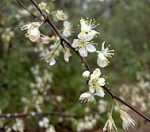 This suckering deciduous tree is also known as American plum and yellow plum and is native to North America from Saskatchewan and Idaho south to New Mexico and East to Quebec, Maine, and Florida where it grows in woodlands, pastures, stream-sides, and abandoned fields. It is a member of the rose family, Rosaceae, that also includes cherry, almond, and lady’s mantle. Plants grow 10-20′ tall and have a shallow spreading root system and main stems with smooth reddish/gray bark that becomes rough, furrowed, and exfoliating as it ages. The branches and twigs are dark reddish-brown and may have thorns. The ovate to oblong leaves are 2-4″ long and have toothed margins. They are dark green on the upperside, paler beneath and turn yellow to orange or red in the fall. In mid-spring before the leaves emerge umbels of 2-5 white flowers appear in the leaf axils. Each flower is about 1″ across, has 5 petals, and are unpleasantly aromatic. The round fruits are 1″ across and are red with bright yellow pulp. Although the fruits are edible they are tart and usually used for jellies and preserves. Plants provide food and/or cover for songbirds, gamebirds, small mammals, white-tailed deer and butterflies. Drought and heat tolerant, wild plum tends to form thickets and is a good choice a screen or barrier. The genus name, Prunus, comes from the Greek word προύνη meaning plum, a prominent member of this genus. The specific epithet, americana, is the Latinized form of America and refers to the native range of the plant. Type: Flowering deciduous small tree
This suckering deciduous tree is also known as American plum and yellow plum and is native to North America from Saskatchewan and Idaho south to New Mexico and East to Quebec, Maine, and Florida where it grows in woodlands, pastures, stream-sides, and abandoned fields. It is a member of the rose family, Rosaceae, that also includes cherry, almond, and lady’s mantle. Plants grow 10-20′ tall and have a shallow spreading root system and main stems with smooth reddish/gray bark that becomes rough, furrowed, and exfoliating as it ages. The branches and twigs are dark reddish-brown and may have thorns. The ovate to oblong leaves are 2-4″ long and have toothed margins. They are dark green on the upperside, paler beneath and turn yellow to orange or red in the fall. In mid-spring before the leaves emerge umbels of 2-5 white flowers appear in the leaf axils. Each flower is about 1″ across, has 5 petals, and are unpleasantly aromatic. The round fruits are 1″ across and are red with bright yellow pulp. Although the fruits are edible they are tart and usually used for jellies and preserves. Plants provide food and/or cover for songbirds, gamebirds, small mammals, white-tailed deer and butterflies. Drought and heat tolerant, wild plum tends to form thickets and is a good choice a screen or barrier. The genus name, Prunus, comes from the Greek word προύνη meaning plum, a prominent member of this genus. The specific epithet, americana, is the Latinized form of America and refers to the native range of the plant. Type: Flowering deciduous small tree
Outstanding Feature: Flowers; fall coloration
Form: Spreading
Growth Rate: Rapid
Bloom: Umbels of 2-5 white 1″ wide flowers in mid-spring
Size: 10-20′ H 15-25′ W
Light: Full sun, part shade
Soil: Average, medium moist to dry, well-drained; drought tolerant when established but needs watering in severe droughts.
Hardiness: Zones 3-8
Care: Cut out dead or diseased branches in early spring; remove suckers to control growth if desired.
Pests and Diseases: Susceptible to plum curculio, brown rot, leaf spot, canker, black knot, aphids, scale, borers and tent caterpillars.
Propagation: Cuttings
Photo Credit: Wikipedia